12 Imitation Crab Myths Debunked
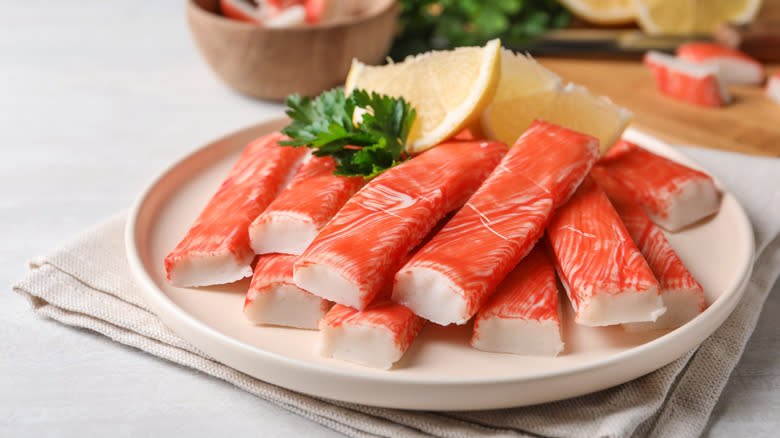
While many of us have probably encountered imitation crab in California sushi rolls, the crab substitute can be found in a surprisingly wide range of dishes from seafood salads to pastas, to crab cakes. Typically made from a blend of deboned white fish, as well as a host of filler ingredients and additives, faux crab meat is cooked and pressed into a variety of shapes such as sticks, chunks, and flakes. The product is usually dyed red to resemble real crab meat.
Often sweet and briny in flavor, imitation crab makes a tasty go-to snack or a convenient addition to a dish. It's also relatively budget-friendly, as it costs much less than real crab meat. This said, fake crab meat is also not as nutritious as its real counterpart due to the way that it's processed. And even if you're not allergic to seafood, it's important to check the packaging for any potential irritants since imitation crab usually contains additives that may or may not touch off a serious allergic reaction.
There's little doubt that imitation crab can make for a yummy — and cost-effective — alternative to real crab. Nevertheless, it's important to be aware of the misconceptions that could impact your purchasing decisions when it comes to this ingredient. Curious about this faux seafood? Read on!
Read more: 16 Little-Known Facts About Salt
False: Imitation Crab Contains Real Crab
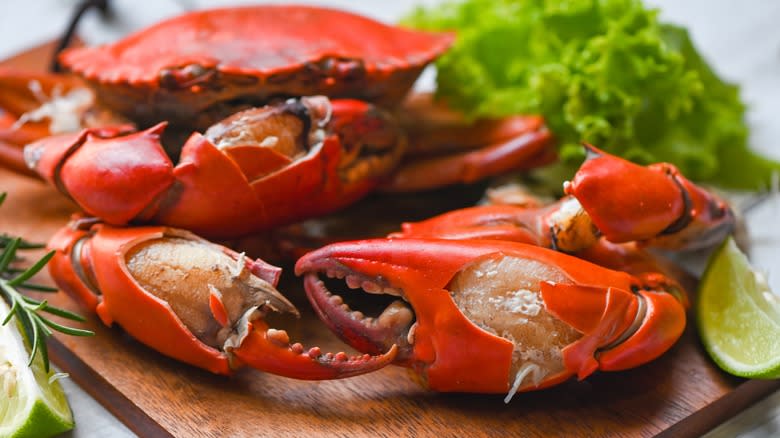
Just like its name suggests, imitation crab usually doesn't contain any crab, nor does it taste all that much like the expensive crustacean. Instead, the predominant ingredient in the food is fish, which is used to make surimi. For those not in the know, surimi is a processed paste made from minced white fish (usually pollock) and a host of other ingredients such as starch, salt, and sugar — all of which are processed together, then shaped, cooked, and dyed to resemble crab meat.
While it's usually quite easy to tell imitation crab apart from the real thing, if you're ever in doubt, take a close look at the label. While most imitation crab products are clearly branded as such, they can sometimes come under other names, such as crab-flavored seafood, crab sticks, krab, and surimi seafood. In Japan, where imitation crab first came to light, it is also typically called kamaboko.
In addition, while processed crab usually only contains crab and water, imitation crab will usually contain an entire shopping list of ingredients, from fillers like starch and egg white to artificial flavoring and preservatives.
False: Imitation Crab Is Always Made From Low-Quality Fish
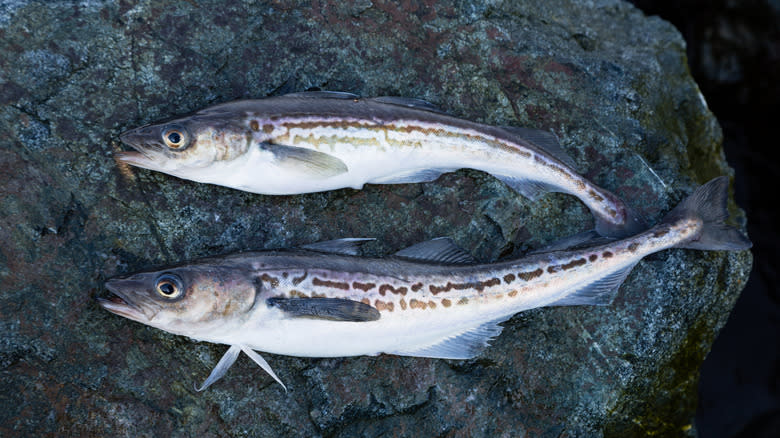
Although imitation crab isn't made from the crustacean whose name it carries, it is still produced from seafood. To be more precise, fake crab meat is made from processed white fish. Sometimes called "the hot dog of the sea," crab sticks are made from deboned, washed, and minced fish flesh. While in the old days, surimi was made from bycatch deemed too low-quality for the grocery store shelves, things have certainly changed since then.
Today, most imitation crab manufacturers use minced Alaska pollock, blue whiting, arrowtooth flounder, or Pacific whiting to make their products. The most frequently utilized fish in substitute crab meat is Alaska pollock, which makes up between 50 to 70% of all surimi. Small amounts of fish oil may also be present in the product.
Also sometimes referred to as walleye pollock, Alaska pollock is native to the North Pacific and the East Bering Sea. It's also one of the most popular fish choices in the U.S. Like many other fish, Alaska pollock is low in calories, high in protein, and a good source of omega-3 fatty acids. It's also low in mercury, making it a relatively safe option for those who are concerned about toxins.
False: Imitation Crab Was Invented In The U.S.
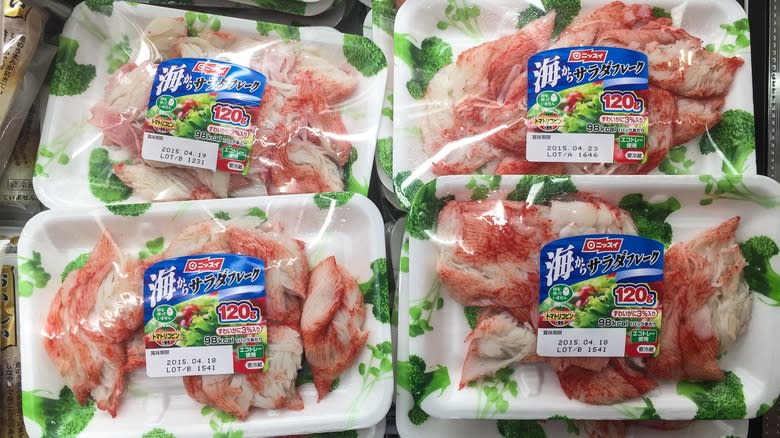
Although crab substitutes are readily available on supermarket shelves in the U.S. today, they were actually invented across the Pacific Ocean in Japan. The practice of grinding and salting fish in Japan dates back hundreds of years. However, it wasn't until the 1960s that surimi started to be made and preserved with sugar, a method that significantly extended its shelf life.
Crab substitute, as we know it today, was first introduced by the Sugiyo company in 1974. Known as "kanimam," the product initially took the form of flakes. Imitation crab flakes are still the main ingredient in kani salad, a Japanese dish that combines the crab proxy with ingredients such as mango and cucumber. Imitation crab sticks, as we know them today, were invented by Osaki Suisan in 1974. The product made its way to America around a decade later, where it started being sold at grocery stores and served at restaurants. By the end of the '80s, Americans were consuming around 135 million pounds of imitation crab annually.
Faux crab meat was invented as a budget-friendly alternative to crab meat, which is considered a high-end item. Even when processed, crab meat can carry a hefty price tag. In the U.S. retail market, real crab can cost as much as $30 per pound, whereas imitation crab sticks are typically much cheaper at around $5 per pound.
False: Imitation Crab Is Extremely Unhealthy
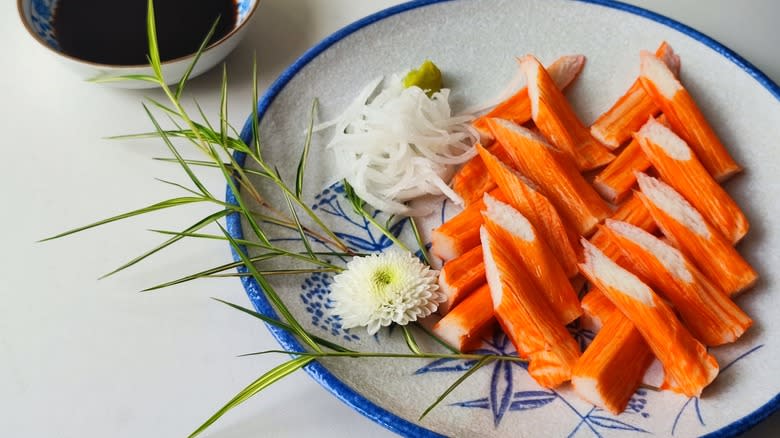
While imitation crab is not necessarily as good for you as eating real crab meat, it's not as devoid of nutrients as some people may believe. However, it's important to remember that since different manufacturers fill their imitation crab with different ingredients, not all products have the same nutritional content. The healthy component of fake crab meat is usually white fish. However, since ground fish only makes up between 35 and 50% of fake crab meat, the exact nutritional lineup of the product can vary depending on the brand and what other ingredients are involved.
Imitation crab arguably has numerous health benefits. It's relatively low in calories, fat, and cholesterol. It's also a decent source of protein and contains key minerals including phosphorus and selenium. While fake crab meat has quite a lot of sodium, with a 3-ounce serving of the product containing around 700 milligrams of the stuff, this is lower than the 900 milligrams of sodium that's typical in the same portion of real crab.
The concern regarding imitation crab is the potential variety of additives that are often used in the product, including artificial flavorings, MSG, gums, and preservatives like sodium benzoate and phosphates (though part of what you don't know about MSG can include the fact that this ingredient isn't necessarily as bad as it was once thought to be).
False: Imitation Crab Is Only Sold As Sticks

While we are mostly familiar with imitation crab sticks, these are not the only form that the seafood proxy can take. In fact, imitation crab meat can be molded into pretty much any shape. Depending on how it was formed, substitute crab meat can also feature different textures. For instance, imitation crab sticks can be aligned lengthwise to mimic the flaky texture of real crab meat. The crab substitute can also be rolled out into sheets, which are then formed into logs. Additionally, surimi can be minced or chopped for a less flaky effect.
Aside from imitation crab sticks, some of the most popular faux crab products include chunks or shredded versions of the product. Surimi can also be fashioned into more imaginative shapes such as crab claws and shrimp. However, not everybody is a fan of chunky or shredded style of fake crab. Dennis Lee, who writes for The Takeout, calls them chewy, gummy, rubbery, and lacking in flavor, adding, "Every flake-style imitation crab meat I've ever had has always had a muted flavor, usually too sweet, and nothing like crab."
False: All Imitation Crab Brands Are The Same
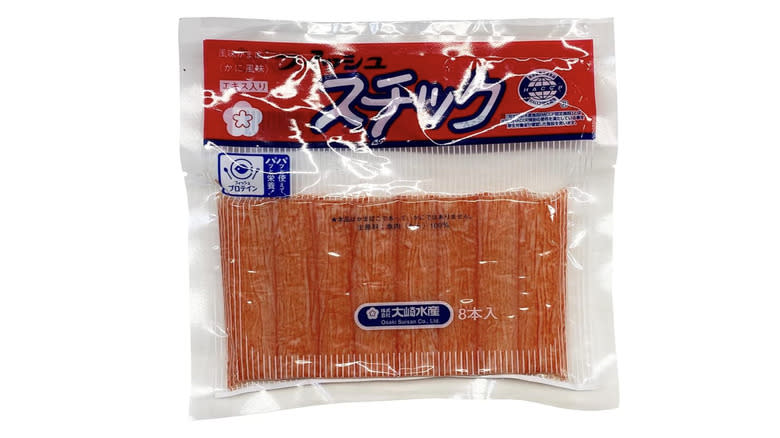
While just about all imitation crab meat contains some sort of white fish, the type of fish and its amounts in comparison to other ingredients can vary from brand to brand. Those different brands contain different amounts of fillers, such as starch, salt, sugar, and eggs. Some faux crab meat also contains additives such as MSG, artificial flavoring, and preservatives. This means that not all fake crab meat is going to taste the same — quite the opposite. While lower quality imitation crab may do the job in casseroles, it's probably best to opt for premium brand options if you're eating the seafood proxy as a snack or making sushi. Take a bite, and you'll likely be able to tell the difference.
In terms of imitation crab brands, Mashed recommends the Japanese Osaki Brand — the same brand that invented imitation crab sticks in the '70s. Available at some Asian stores in the U.S., Osaki imitation crab is another favorite and is made with Alaska pollock, southern blue whiting, wheat starch, egg whites, cornstarch, rice wine, crab extract, and MSG.
False: Imitation Crab Needs To Be Cooked
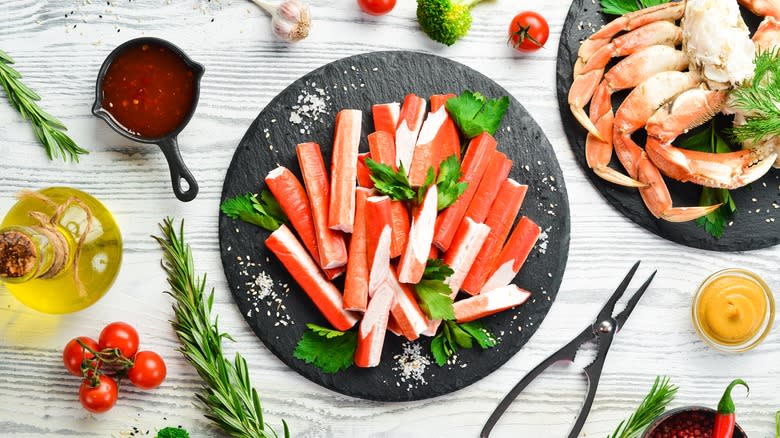
Thinking that imitation crab is raw and can't be eaten straight out of the package is a common misconception that boils down to a lack of information about how it's typically made. In reality, the fish and other ingredients that make up imitation crab are thoroughly cooked. The resulting paste is then shaped and pasteurized to rid it of any bacteria. This process makes the product safe to consume without being subjected to high temperatures. Of course, you can still warm up imitation crab if you're adding it to certain dishes, but that's more of a taste preference than a necessity.
Given that practically all brands are pre-cooked, imitation crab can substantially cut down on prep time in the kitchen. Nevertheless, when dealing with faux crab meat, it's still important to pay attention to a number of other safety considerations. For instance, people who are allergic to fish, gluten, crab extract, and eggs should be especially mindful of the ingredients listed on imitation crab products. Those sensitive to allergens should also be wary of unlabeled crab substitutes, as well as imitation crab that may be served as appetizers at events.
False: Imitation Crab Only Belongs In Sushi
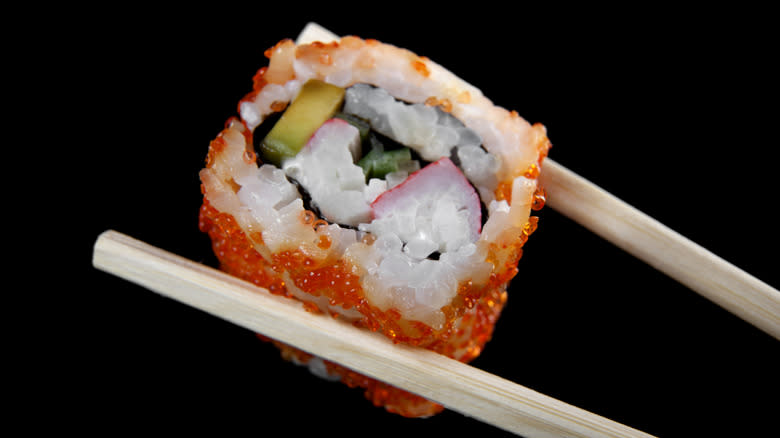
Most of us are familiar with the form of sushi known California rolls. Made with crab stick meat, avocado, and cucumber, the ubiquitous sushi staple can be found on the menus of many Japanese restaurants in the U.S. True to the name, California rolls were invented in 1960s Los Angeles by Ichiro Mashita, a Japanese sushi chef who decided to combine American and Japanese flavors to make the bite-sized morsels more approachable to diners not keen on eating raw fish (as well as the more traditional seaweed-based nori wrapping).
Although many of us associate imitation crab with California rolls, the seafood substitute can be used in a wide range of recipes. Crab sticks make a great snack or appetizer. To make air fried crab sticks, simply slather each piece in butter and seasoning (or coat in eggs and breadcrumbs) and pop them in the air fryer. Alternatively, make fried crab Rangoon wontons with imitation crab, cream cheese, green onion, and garlic. Fake crab can also make a good replacement for real crab meat in recipes such as crab pasta salads or crab cakes.
False: Imitation Crab Is Always Cheap
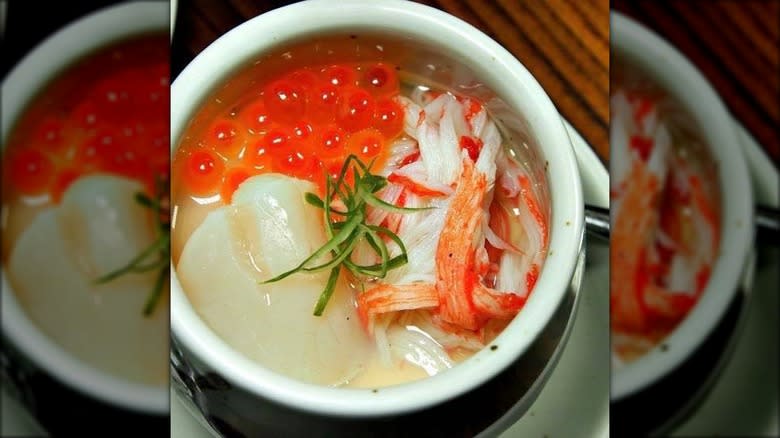
While one of the upsides of imitation crab is its low price tag, not all crab substitutes are budget-friendly. In fact, in Japan, high-end imitation crab is becoming something of a delicacy. The product is specifically made to resemble the flavor and texture of the real thing. This price trend seems to be spreading globally, with one Reddit user posting a photo of a 12-ounce portion of an imitation crab-stuffed dish for $13.98 and complaining: "Is it just me or is the price of imitation crab meat getting out of whack."
Some imitation crab manufacturers are even experimenting to bring consumers more sophisticated versions of the product. For instance, in 2023 Japanese company Sugiyo launched Kaoribako Kiwami. Based on the flavor of snow crab, the product marries the umami flavor of male crabs with the juicy texture of female crabs, as well as a "secret ingredient" that gives it the aroma of real crab. In addition, some imitation crab products in Japan actually contain real crab meat, a factor that, according to Keiko Kubo of JETRO, a Japanese trade organization, elevates them to "sushi grade" and makes them more expensive.
False: Imitation Crab Has A Long Shelf Life
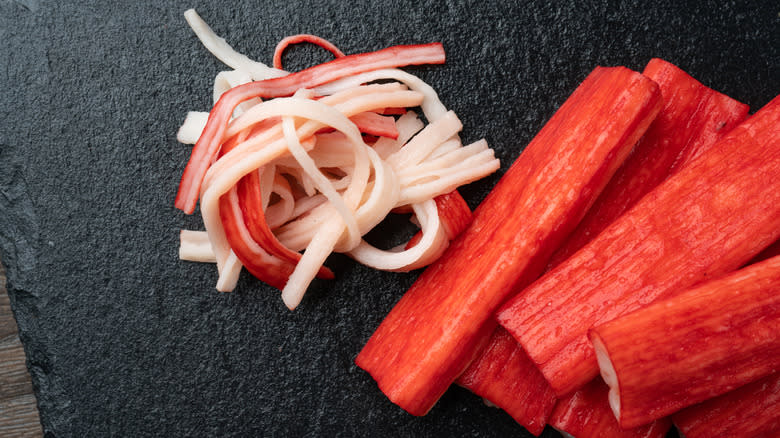
While imitation crab may look like a product that could be left in the refrigerator for months, the real story is a little different. In fact, once the vacuum-sealed packaging is opened, fake crab should be treated like any other seafood. The USDA recommends that cooked seafood, such as imitation crab, be stored in the refrigerator for up to three or four days. Of course, that's provided that the refrigerator's internal temperature is under 40 degrees Fahrenheit. Once taken out of the refrigerator, imitation crab should be eaten within two hours.
Vacuum-sealed packages of imitation crab can be kept in the refrigerator until their use-by or sell-by date. If you don't think you will be able to eat the product within that time period, you can freeze it to prolong its shelf life to nine months. Once thawed, the product should be eaten within three days regardless of whether it has been taken out of the packaging or not.
To thaw imitation crab, transfer it from the freezer to the refrigerator 24 hours before use. Alternatively, soak the product in lukewarm water for between 15 minutes and an hour, based on the package size. If you're not sure if your crab proxy is still safe to eat, then turn to your senses. Took a look at and a whiff of the imitation crab; if you detect an unpleasant fishy odor, slimy surface, or sour taste, then those are sure signs of spoilage.
False: Imitation Crab Has No Environmental Impact
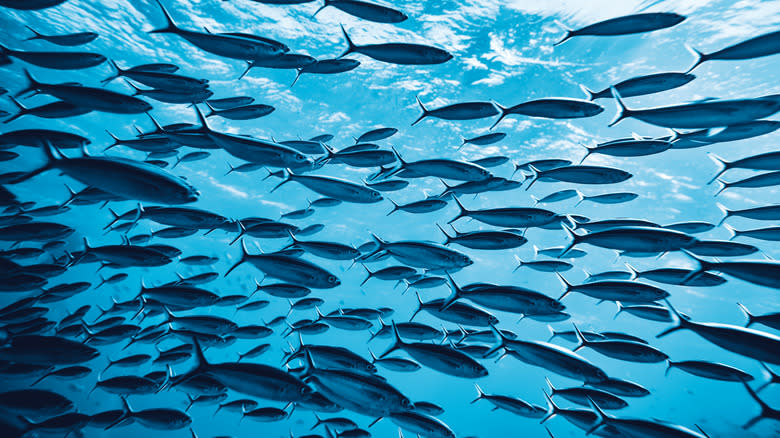
If you think that by eating imitation crab — as opposed to real crab — you're doing your bit for the environment, you may want to rethink your strategy. This is because surimi often contains Alaska pollock, or another species of white fish. More precisely, approximately 2-3% of the global fish haul has historically been used to make surimi, as per a 2007 report by the GLOBEFISH Research Programme. While NOAA Fisheries currently states that Alaska pollock isn't being overfished in the Eastern Bering Sea and other Alaska-adjacent fisheries, the situation in other areas isn't as clear. What we do know, however, is that the extraction of Alaska pollock has an effect on other sea life and the marine habitat.
The ecological repercussions associated with imitation crab vary across the industry. While some manufacturers are mindful of sustainable fishing practices, others aren't as conscientious. For instance, certain fishing methods can cause significant damage to marine habitats. They can also result in high levels of bycatch, where unintended sea life is caught and even discarded.
False: Imitation Crab Is Unlikely To Cause Allergic Reactions
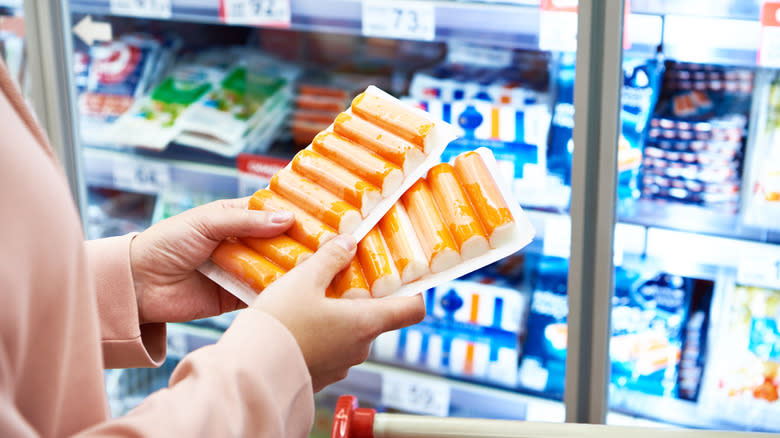
Since imitation crab contains fish, it's not an option for those following a vegetarian or vegan diet. However, that's not the whole story. Imitation crab often also contains starch and wheat, which means that it's not suitable for people with celiac disease or those sensitive to gluten. That said, there are brands that produce gluten-free imitation crab, such as Trans-Ocean imitation crab, a company that has been certified by the National Foundation for Celiac Awareness as a gluten-free food processor (via Trans-Ocean).
People sensitive to certain allergens should always read the label on imitation crab products, much as they would for any other food. This is necessary even if you're already familiar with a product, as one Reddit user claimed: "Aldi got me once, for years their Fremont imitation crab was gluten free. They changed suppliers during the beginning of the pandemic (when I was ordering grocery pickup and thus not checking labels in store) to one that uses wheat, yet the packaging looked exactly the same."
Aside from gluten, imitation crab may contain other allergens. While surimi is normally made from fish, it can contain traces of crab, making it a no-no for those who are allergic to shellfish. Imitation crab can also include other potential allergens such as eggs, milk, and tree nuts. Additionally, anyone who may be sensitive to MSG should keep an eye out for glutamic acid, monosodium glutamate, or glutamate on the product's ingredients list.
Read the original article on Mashed


